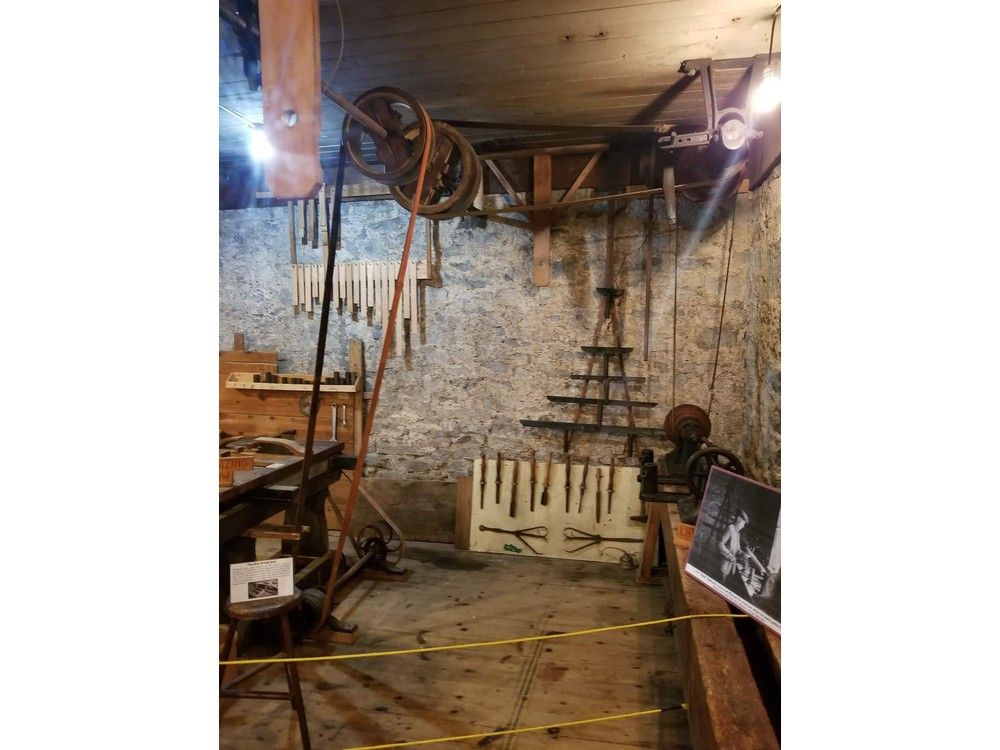An experienced mill operator, the United Empire Loyalist was inspired by the abundance of suitable land parcels in the Ernestown area. Joshua Booth became a prosperous businessman, and his descendants developed one of his properties into a hub of production with the help of experienced local masons. In 1907, John H.
Babcock purchased the mill to establish a basketmaking operation. Now a fascinating museum, Babcock Mill at Odessa, Ontario resonates with industrial history. Toward the end of the American Revolution, United Empire Loyalist sergeant Joshua Booth (b.

circa 1759, New York) and his wife Margaret Fraser arrived in eastern Ontario, west of Kingston. Establishing a home, the Booths raised a family of eleven children in Ernestown Township. Receiving land grants for his military service, Booth “acquired at least another 1,500 acres of land in Ernestown and Thurlow townships as a result of successful petitions on his and his wife’s behalf,” said J.
K. Johnson in Dictionary of Canadian Biography , Vol, 5, 1983. Booth was industrious, launching into building gristmills and sawmills in 1793 on land between Kingston Township and Ernestown Township, behind the Collins Bay area.
Respected and popular, Booth was considered one of area’s most prosperous residents. The Loyalist was also “granted a lease of the ‘King’s Mill’ at Ernestown, a sawmill on lot 18, concession 5” in 1802, said Johnson, after legal skirmishes with other businessmen who were interested in the property with much potential. It was a 21-year lease only, though—the property was still reserved by the Crown.
Entering the political fray, Booth was elected to represent Ontario & Addington in the first Legislative Assembly of Upper Canada, serving under Lieutenant Governor John Graves Simcoe in the Legislature until 1796. Appointed Justice of the Peace for Midland District, Booth was less than dedicated to the post, rarely attending sessions. He was more interested in duties “as a member of the Heir and Devisee Commission which was responsible for settling Loyalist land claims,” stated Historical Narratives of Early Canada .
“He attended three of its four sessions.” Booth’s sons and grandsons were part of the family business. After the death of 53-year-old Joshua Booth (suddenly while on duty, leading a militia detachment on October 27, 1813), his son, Joshua, established “the first pearl and pot barley factory in Upper Canada in 1817,” wrote Larry Turner in Ernestown: Rural Spaces, Urban Places (Dundurn Press, Toronto 1993).
Joshua’s brother, Benjamin, negotiated another 21-year lease on the King’s Mill, and then the Booths commences construction of “fulling, carding, and cloth mills.” Benjamin Booth’s sons John and Philip (and another named Joshua) were enthusiastic developers as well, building gristmills and sawmills, plus homes on Factory Street and nearby. The Booth family members “were largely responsible for the creation of Mill Creek, now Odessa, where they built three of the finest homes in the township,” Turner noted.
Contracting the Saul Brothers in 1856, John and Philip Booth constructed a limestone mill on the edge of Mill Creek (now known as Millhaven Creek). The Saul Brothers were close but not actually brothers. Hugh and William Saul were first cousins who partnered in business.
Born in County Down, Ireland, the Sauls learned the masonry trade from family members, and “did most of their stonework in Glasgow, Edinburgh, and Greenock Scotland,” said their descendant Don Karr Saul (1927-2020, Kingston). Immigrating to Canada to build abutments for the Victoria Tubular Bridge at Montreal, Quebec, the men “also worked on St. Anne’s Bridge as well as stonework for the Grand Trunk Railway as far as Ernestown Station.
” Settling in the village of Newburgh, the Saul men excelled in their trade. The masons completed 18 churches throughout the area including at Yarker, Selby, Tamworth, Harrowsmith, Camden East, and more. Most were Methodist Churches, and several places of worship for Presbyterian, Roman Catholic, and other faiths.
Homes and schools were part of the Saul business repertoire, along with mills, said The Daily British Whig, in “The Late Hugh Saul,” May 8, 1911. Applying their expertise to the Booth Ernestown mill, the Sauls began each day with an extensive breath of fresh air. “While building the Mill, they would walk over 25 kilometres each day from Newburgh and back for work,” mentioned Nicole Mulder, Kingston & Area Association of Museums, Art Galleries, and Historic Sites , July 27, 2023.
The Booths initially wanted a gristmill, but progress disrupted their plan. Chugging across the province, the Grand Trunk Railway line was established in 1856, making more affordable goods available by train. The Booth family changed direction.
The Mill was one of several factories on the lot, so they “used the Mill as a salesroom, storage, and office space for their family’s woollen mill,” Mulder said. Noisy, dusty, productive, the Odessa site of the Booth mills was a hubbub of activity. A devoted member of the Methodist Church.
mason Hugh Saul gave “his heart to God fifty-five years ago at a revival meeting in Odessa,” described The Daily British Whig . The contractor attended church at Camden East and helped with a building fundraiser in 1909. “He collected over one thousand dollars for the new tower and repairs to the church which he loved so well.
” The Saul cousins died only months apart in 1911, it appears each was in his 80s. In 1907, John H. Babcock purchased the Mill and sawmill from the Booth family.
Babcock “installed the present equipment and operated the mill, planning lumber, doing custom mill work,” said Heather Chevalier in “Babcock Family & Mill, Odessa Ontario.” He patented basket-making equipment in 1915 and 1919 and produced his memorably titled “Better Baskets by Babcock.” John Babcock died in 1946; his sons, Roy and Oscar Babcock, “manufactured truck bodies until the late 1960s.
” The Township of Ernestown (now Loyalist Township) purchased the historical Babcock Mill in 1977, and the Mill was renovated and restored, displaying the history of the region and several of its founding families. “In 1986 the Township contracted Don Babcock (grandson of J.H.
Babcock) to reconstruct and repair the original basket making machinery,” added Chevalier. On the bank of the rippling Millhaven Creek, the Babcock Mill Museum is highlighted by beautiful park space, celebrating the history of industry in the community of Odessa. Susanna McLeod is a writer living in Kingston, Ontario.
.



















